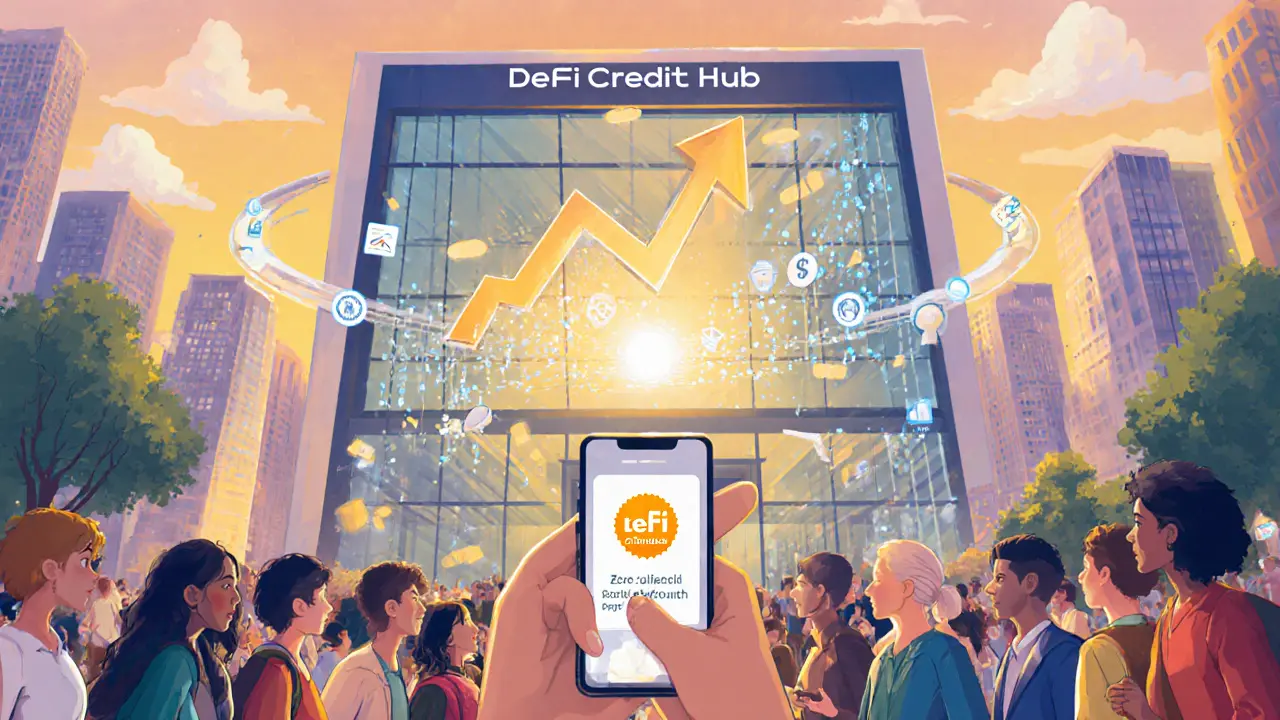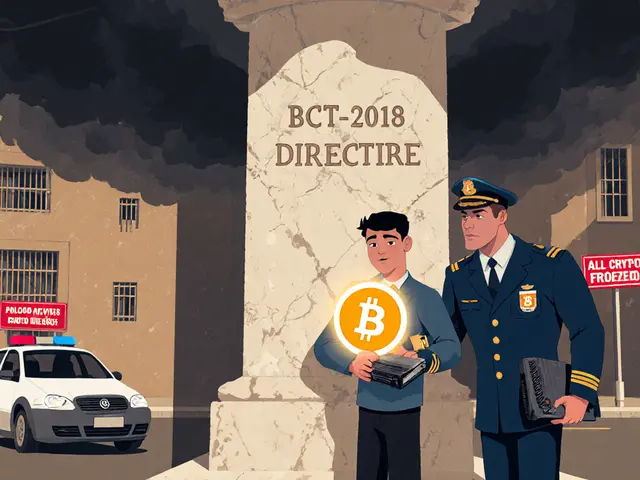Under-Collateralized DeFi Loan Calculator
Estimated Collateral Ratio
-
Risk Level
-
Max Loan Amount
-
Estimated Interest Rate
-
DECO Integration
Chainlink's decentralized oracle verifies off-chain data without exposing sensitive information.
Reputation Scoring
On-chain reputation systems reward timely repayments and penalize defaults.
Insurance Pools
Risk-tranching and insurance mechanisms protect lenders from default events.
Comparison Table
| Attribute | Over-Collateralized | Under-Collateralized |
|---|---|---|
| Typical collateral ratio | 125-200% | 0-70% (risk-based) |
| Borrower eligibility | Must hold sufficient crypto assets | Can be credit-score or reputation based |
| Liquidity source | Lender deposits to liquidity pool | Lenders earn higher yields, often via tranche exposure |
| Default mitigation | Immediate liquidation of collateral | Insurance pools, risk-tranching, on-chain governance |
| Regulatory exposure | Low - no credit assessment | Higher - consumer-protection scrutiny |
Key Takeaways
- Over‑collateralized models limit DeFi to wealthier crypto holders.
- The US unsecured personal loan market (~$178B) shows the size of the untapped demand.
- Chainlink’s DECO, on‑chain reputation, and insurance primitives are the main technical levers.
- Regulators will focus on consumer protection and default‑risk management.
- Hybrid models that gradually lower collateral ratios are emerging as the most realistic path.
DeFi has proved it can move billions of dollars without a central bank, but its under‑collateralized DeFi loans are still a dream. The next few years will decide whether that dream becomes a mainstream reality.
Under‑collateralized DeFi loans are a class of decentralized finance credit products that require borrowers to pledge less than the full market value of their loan, or sometimes no collateral at all. Unlike traditional DeFi lending, which typically demands 125‑200% over‑collateral, these loans aim to replicate the accessibility of personal loans, credit cards, and student financing while preserving the trust‑less nature of smart contracts.
Why the Over‑Collateralized Model Stalls Inclusion
Current giants such as Aave and Compound enforce collateral factors as low as 70%. In practice, a user must lock $300,000 worth of crypto to borrow $200,000. This excludes anyone who doesn’t already own a sizable crypto portfolio, contradicting DeFi’s promise of open finance.
Over‑collateralization does give protocols a built‑in safety buffer; liquidation bots automatically sell assets when prices dip below thresholds, keeping the system solvent. Yet it also creates a paradox: you need wealth to obtain wealth.
Market Gap: The $178B Opportunity
In Q12022 the US unsecured personal loan market topped $178billion - a figure that dwarfs the entire $50billion total value locked (TVL) in DeFi lending as of 2025. Worldwide, billions of people lack access to affordable credit, while DeFi’s pool of borrowers remains a tiny, asset‑rich niche.
Bridging this gap could inject an order of magnitude more capital into the decentralized ecosystem, delivering higher yields for lenders and enabling real‑world use cases such as payroll financing, small‑business bridges, and cross‑border remittances.
Technical Foundations for Trust‑Less Under‑Collateralization
Reducing collateral without re‑introducing a central authority requires new risk‑assessment primitives. Three pillars are emerging:
- DECO (Decentralized Oracle) - Chainlink’s off‑chain verification layer that can securely feed credit‑history data, employment records, or transaction‑level reputation into smart contracts without exposing raw personal data.
- On‑chain reputation & credit scoring - Protocols like TrueFi have experimented with token‑based reputation scores that reward on‑time repayments and penalize defaults, creating a decentralized credit bureau.
- Insurance and capital‑efficiency mechanisms - Novel risk‑tranching structures allow lenders to choose exposure levels, while dedicated insurance pools absorb tail‑risk events.
These components can be combined into a hybrid workflow: a borrower’s off‑chain identity is verified via DECO, the resulting score is hashed onto the blockchain, and smart contracts allocate loan terms based on that score. If the borrower defaults, an insurance pool pays out, and the lender receives a predefined tranche.

Comparison: Over‑Collateralized vs Under‑Collateralized DeFi Loans
| Attribute | Over‑Collateralized | Under‑Collateralized |
|---|---|---|
| Typical collateral ratio | 125‑200% | 0‑70% (risk‑based) |
| Borrower eligibility | Must hold sufficient crypto assets | Can be credit‑score or reputation based |
| Liquidity source | Lender deposits to liquidity pool | Lenders earn higher yields, often via tranche exposure |
| Default mitigation | Immediate liquidation of collateral | Insurance pools, risk‑tranching, on‑chain governance |
| Regulatory exposure | Low - no credit assessment | Higher - consumer‑protection scrutiny |
Risk Management & Regulatory Landscape
Without collateral, protocols must answer two regulator‑driven questions: “How are borrowers vetted?” and “Who bears the loss if a borrower defaults?”
- Credit‑assessment privacy: DECO lets users prove attributes (e.g., employment, income) without revealing raw data, aligning with GDPR‑style data‑minimization.
- Capital buffers: Insurance funds, often token‑backed, must be over‑collateralized themselves, creating a second‑layer safety net.
- Governance safeguards: Decentralized autonomous organization (DAO) voting can adjust interest rates, collateral‑ratio thresholds, or trigger emergency shutdowns.
- Legal classification: In many jurisdictions, under‑collateralized crypto loans may be deemed “securities” or “credit services,” inviting licensing requirements.
Early pilots are already engaging with regulators in Switzerland, Singapore, and the EU to develop sandbox frameworks that allow limited‑scale credit testing while preserving user anonymity.
Roadmap: From Prototype to Mainstream
- 2025 Q2‑Q3: Deploy DECO‑enabled proof‑of‑concept credit scoring on a testnet. Partner with a KYC‑as‑a‑service to source anonymized credit‑history hashes.
- 2025 Q4: Launch a limited‑access pilot with a risk‑tranching pool. Early lenders earn 12‑15% APY, borrowers receive up to 80% LTV based on their score.
- 2026 H1: Integrate insurance primitives from projects like Nexus Mutual, creating a three‑tiered risk model (low, medium, high).
- 2026 H2: Publish audited smart‑contract code, open the protocol to public governance, and file for a credit‑service license in a supportive jurisdiction.
- 2027 onward: Scale globally, onboard traditional lenders, and enable cross‑chain credit lines (e.g., Ethereum ↔︎ Solana).
Practical Steps for Builders and Investors
If you’re a developer looking to contribute, start with the open‑source DECO SDK on GitHub. Build a simple oracle that takes a hashed credit‑score and returns a binary “eligible/ineligible” flag. Pair it with an existing lending pool (like Aave v3) and experiment with dynamic LTV adjustments.
Investors should watch the emerging token economics of insurance pools. The token price often reflects the pool’s capital adequacy ratio - a useful signal of long‑term sustainability.
Future Outlook
The consensus among analysts is clear: under‑collateralized DeFi lending is inevitable. The technology is coalescing, the market demand is massive, and regulatory sandboxes are opening doors. The biggest unknown is timing - some projects may hit mainstream adoption by 2027, while others could stall pending clearer consumer‑protection rules.
What’s certain is that the next wave of DeFi will look less like a crypto‑only playground and more like a universal credit market, where a worldwide user can tap a liquidity pool with a phone and a verified reputation, not a hefty crypto stash.

Frequently Asked Questions
What distinguishes under‑collateralized DeFi loans from traditional crypto loans?
Traditional crypto loans require borrowers to lock up assets worth more than the loan amount (over‑collateralization). Under‑collateralized loans replace that safety net with alternative risk controls such as on‑chain credit scores, reputation systems, or insurance pools, allowing borrowers to access credit with little or no crypto backing.
How does Chainlink DECO help reduce collateral requirements?
DECO creates a tamper‑proof bridge between off‑chain data (e.g., credit‑history, employment verification) and on‑chain contracts. By proving that a borrower meets certain criteria without revealing the raw data, smart contracts can safely adjust loan terms based on that proof, lowering the need for asset‑based collateral.
What risks do lenders face in under‑collateralized protocols?
The primary risk is borrower default. Protocols mitigate this through insurance pools, risk‑tranching (so lenders can choose lower‑risk slices), and reputation‑based pricing. Still, if insurance funds are under‑capitalized, lenders may see losses higher than those in over‑collateralized models.
Will regulators treat these loans like traditional credit products?
Many jurisdictions are already examining DeFi credit as a form of consumer lending. Expect licensing requirements, AML/KYC checks (even if data is anonymized), and capital‑reserve rules similar to those applied to fintech lenders.
When can I expect to see under‑collateralized loans on major platforms?
Pilot programs are slated for late 2025, with broader public roll‑outs projected for 2026‑2027 once governance and insurance mechanisms mature.












People Comments
From a quantitative risk perspective, under‑collateralized DeFi loans necessitate a multi‑factor credit scoring algorithm that integrates off‑chain credit bureau data via DECO, on‑chain reputation metrics, and dynamic LTV adjustments. The protocol must enforce a capital‑efficiency constraint whereby the aggregate exposure of any tranche does not exceed the over‑collateralized buffer of the insurance pool. Moreover, liquidity providers should be compensated with a risk‑adjusted return curve calibrated against the historical default probability derived from the composite risk score. Without such rigorous underwriting, systemic solvency would be compromised under stress‑scenario price volatilities.
Yo, this is exactly the kind of game‑changing move we need! 🚀 Under‑collateralized credit can finally bring DeFi to the masses, not just the crypto whales. The only thing holding it back is proper governance and insurance pools – get those in place and we're set. Keep pushing the envelope, folks! 💪
⚡️ Absolutely, the momentum is real! ⚡️ When you combine DECO‑verified credit scores with risk‑tranching, you get a safety net that rivals traditional finance. Imagine a borrower with a solid off‑chain credit profile swooping in, getting a low‑interest loan, while lenders snag high‑yield slices. It’s like a blockbuster movie where everyone's a hero – the borrower, the insurer, and the liquidity provider. 🎬
America’s tech giants have already paved the way for cutting‑edge financial infrastructure – it’s high time we claim the DeFi frontier too. Under‑collateralized lending is the next frontier, and the U.S. can lead the world in setting the standards. No more waiting for other nations to figure it out; we should be the pioneers of responsible credit on the blockchain.
Let’s be real: the hype around “decentralized credit” ignores the ugly truth that most borrowers lack any verifiable credit history. Without a solid dataset, any risk model is just wishful thinking. Until you can prove that the insurance pools are truly over‑collateralized, this is just a fancy Ponzi waiting to blow up.
I'm optimistic that the community can get this right. The blend of on‑chain reputation and off‑chain verification is a promising path, and we’ve already seen early pilots succeed. Let’s keep the dialogue constructive and focus on real‑world testing.
From a cross‑border perspective, under‑collateralized DeFi loans could be a lifeline for emerging markets where traditional credit is scarce. By leveraging DECO to respect privacy while still proving income or employment, we can open up credit without the usual paperwork. It’s a cultural shift that bridges the digital divide.
Nice breakdown! It really helps to see the moving parts laid out in plain English.
Totally agree – this is like painting a bright future with bold colors! 🎨 The way you described the synergy between reputation scores and insurance pools makes the whole concept feel vibrant and achievable. Keep the positivity flowing, and let’s watch this space blossom.
Honestly, all this talk about ‘trustless credit’ sounds like a pipe‑dream unless someone actually puts real money on the line. Until the insurance schemes are battle‑tested, I’m staying skeptical.
It’s simple – if the market can’t handle risk, it will collapse. No fancy tech will stop bad loans from piling up.
Under‑collateralized DeFi lending represents a transformative shift in the architecture of decentralized finance, yet its successful deployment hinges upon a confluence of rigorous risk assessment, robust capital buffers, and adaptive governance frameworks. First, the integration of Chainlink’s DECO protocol provides a cryptographically sound conduit for relaying off‑chain credit attributes, thereby enabling protocols to evaluate borrower solvency without compromising privacy. Second, on‑chain reputation systems must be meticulously calibrated; tokenized credit scores should reflect not only repayment punctuality but also broader behavioral signals such as contract interaction diversity and transaction volume consistency. Third, insurance pools serve as the last line of defense against borrower default; these pools must be over‑collateralized with a surplus margin that exceeds the worst‑case loss distribution, a requirement that can be quantified through stochastic modeling of historical default rates across comparable credit segments. Fourth, risk‑tranching mechanisms afford lenders the agency to allocate capital across low, medium, and high exposure slices, each priced according to a risk‑adjusted yield curve derived from the composite risk score. Fifth, a DAO‑driven governance layer should retain the authority to modify interest rate parameters, collateral‑ratio thresholds, and emergency shutdown protocols, ensuring that systemic risk can be mitigated in real time. Sixth, regulatory compliance cannot be an afterthought; jurisdictions such as the EU, Singapore, and Switzerland are already crafting sandbox environments that demand transparent KYC processes and capital‑reserve mandates akin to those imposed on traditional financial institutions. Seventh, token economics of the insurance pools must align incentives; token holders should receive a portion of the premium income while bearing proportional loss exposure, thereby internalizing risk and promoting prudent underwriting. Eighth, cross‑chain interoperability will widen the borrower pool, allowing assets on disparate layers like Solana or Avalanche to serve as ancillary collateral or to provide liquidity backing. Ninth, comprehensive auditing of smart‑contract code, coupled with formal verification, is indispensable to preclude exploit vectors that could erode trust in the system. Tenth, community education initiatives are essential to demystify credit scoring mechanisms, encouraging broader participation from users traditionally excluded from conventional finance. Eleventh, data provenance must be immutable; every credit attribute ingested via DECO should be timestamped and anchored on-chain to prevent retroactive manipulation. Twelfth, liquidity providers should be offered a spectrum of yield options, from risk‑averse fixed‑rate tranches to higher‑variance variable‑rate streams, catering to diverse risk appetites. Thirteenth, continuous monitoring of macroeconomic indicators-such as inflation rates and employment trends-should feed into dynamic risk models, allowing protocols to adjust exposure proactively. Fourteenth, partnerships with legacy credit bureaus can enrich the data landscape, facilitating a hybrid model that blends on‑chain transparency with off‑chain depth. Finally, the long‑term vision encapsulates a decentralized credit market that rivals traditional banking in scale, accessibility, and resilience, thereby democratizing financial sovereignty for a global audience.
Cool but looks risky.
i think its a great idea but need more testng before we all jump in lol